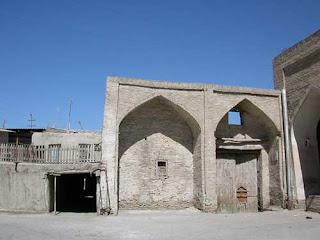Gaukushan Madrasah
Madrasah Gaukushan (Gaukushon) (Uzb. Govkushon madrasasi) is a madrasah building of the Khoja-Gaukushan architectural ensemble in the historical center of Bukhara (Uzbekistan), erected in 1562-1565 under the Uzbek ruler Abdullah Khan II at the expense of a representative of the clergy of the Juybar sheikh - Khoja Sa'ad, known by the nickname “Khoja Kalon”, which is reflected in the name of the complex. Located to the west of the dome of the Toki-Sarrafon money changer behind the buildings of Russian architecture of the late 19th - early 20th centuries
The layout of the madrasah is traditional, it consists of halls that were former classrooms and a mosque, a courtyard, surrounded in a circle by one-story hudjras. The two-bay madrasah received a trapezoidal plan, which was due to the shape of the area being built [1]. While the entire building was one-story, to make it more monumental, the main façade was made two-story. This technique was then used in later madrassas of Bukhara, Khiva and other regions of Transoxiana





Комментарии
Отправить комментарий